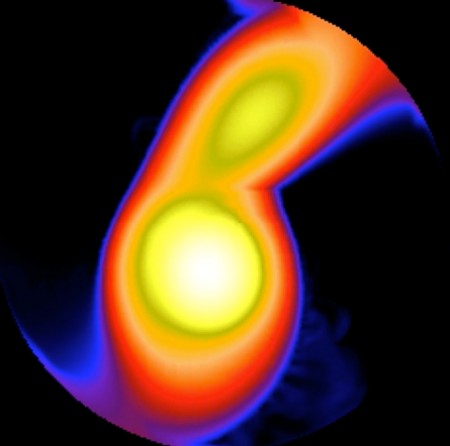Scientists Observe Two Stars Joining Together. All Naughty Like.
From what I understand, scientists and astronomy wizards have long since speculated that stars could spin so closely to one another that they may actually touch. Shit has popped off lately though, as scientists have been able to directly observe the merger of two closely orbiting stars.
Science News:
V1309 Sco was discovered in 2008 when it erupted in a bright flare. Astronomers have proposed various explanations for the burst since then without reaching a consensus.
The new work hinges on a piece of good luck: Tylenda realized that the Optical Gravitational Lensing Experiment, a Warsaw University Observatory project hunting for dark matter since the mid-1990s, had been pointing its telescope at V1309 Sco’s region of the sky for years. Trolling through more than 2,000 observations taken from 2002 to 2010, he and his colleagues found light variations that suggest V1309 Sco was originally a contact binary star, a just-touching pair of stars circling each other about every 1.4 days. Over time, this periodic variation shortened as the stars’ outer layers combined to cocoon both orbs in a single envelope.
At that point the object got brighter, its light doubling every 19 days until late August 2008, when it brightened by a factor of 300 over 10 days. V1309 Sco’s final burst occurred that month when the stars’ cores finally merged and energy from their combined spins erupted outward. It became 10,000 times brighter than its original luminosity and more than 30,000 times brighter than the sun, then quickly faded away over the course of a few months to roughly its original brightness.
The best explanation for these variations is the merger of a contact binary system, Tylenda and his colleagues assert.
While the resulting object should be a star – albeit one with a weird gut structure and a quick spin – the material thrown off during coalescence still largely blocks V1309 Sco, so astronomers can’t see what it looks like. Astronomers have requested time on the Hubble Space Telescope to observe the object, says Williams, but it may take years for the disk to dissipate, notes Stefan Kimeswenger of the University of Innsbruck in Austria.
Galactic fornication. I know, I peddle drivel. We’re talking about cosmic collision, the merging of stars, and all I can think of is my cock. Apologies.




